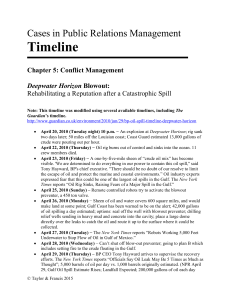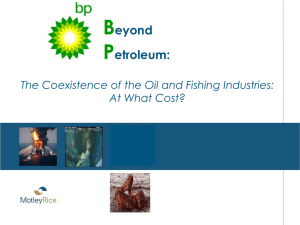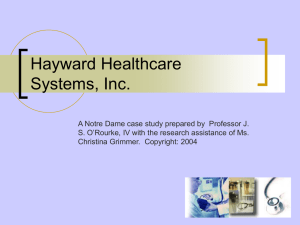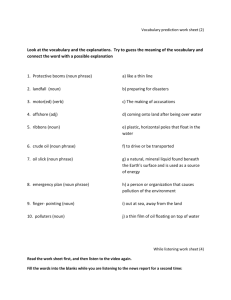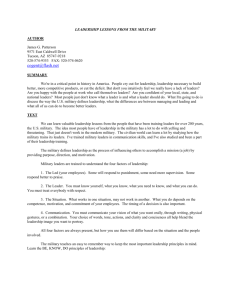BP Oil Spill - WordPress.com
advertisement
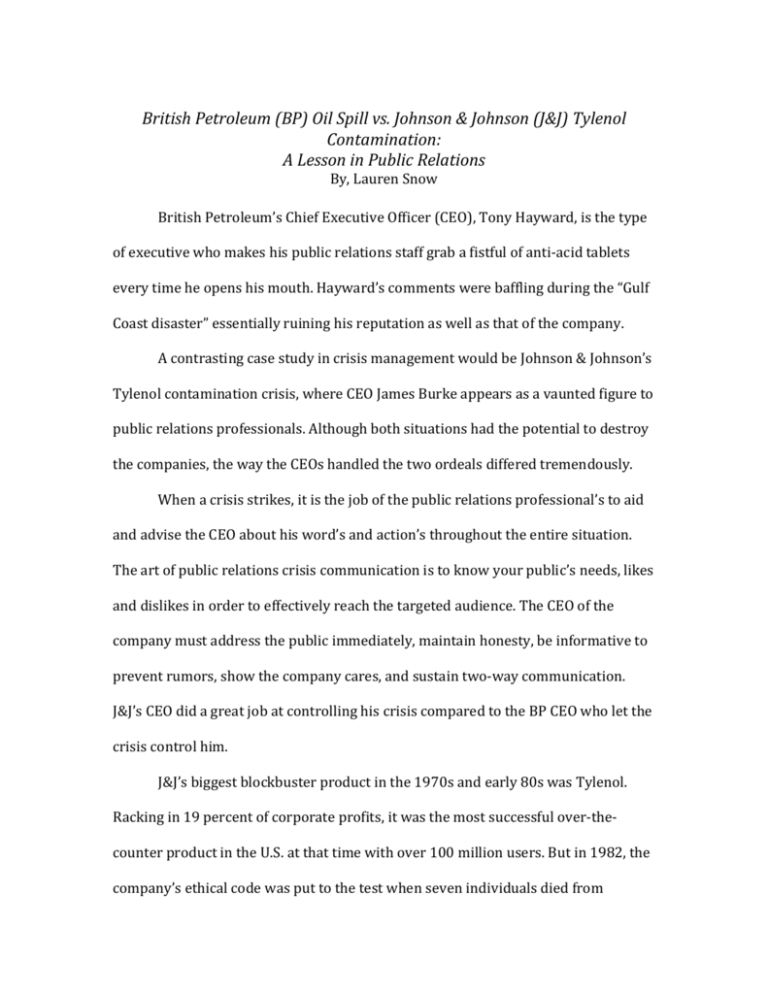
British Petroleum (BP) Oil Spill vs. Johnson & Johnson (J&J) Tylenol Contamination: A Lesson in Public Relations By, Lauren Snow British Petroleum’s Chief Executive Officer (CEO), Tony Hayward, is the type of executive who makes his public relations staff grab a fistful of anti-acid tablets every time he opens his mouth. Hayward’s comments were baffling during the “Gulf Coast disaster” essentially ruining his reputation as well as that of the company. A contrasting case study in crisis management would be Johnson & Johnson’s Tylenol contamination crisis, where CEO James Burke appears as a vaunted figure to public relations professionals. Although both situations had the potential to destroy the companies, the way the CEOs handled the two ordeals differed tremendously. When a crisis strikes, it is the job of the public relations professional’s to aid and advise the CEO about his word’s and action’s throughout the entire situation. The art of public relations crisis communication is to know your public’s needs, likes and dislikes in order to effectively reach the targeted audience. The CEO of the company must address the public immediately, maintain honesty, be informative to prevent rumors, show the company cares, and sustain two-way communication. J&J’s CEO did a great job at controlling his crisis compared to the BP CEO who let the crisis control him. J&J’s biggest blockbuster product in the 1970s and early 80s was Tylenol. Racking in 19 percent of corporate profits, it was the most successful over-thecounter product in the U.S. at that time with over 100 million users. But in 1982, the company’s ethical code was put to the test when seven individuals died from Tylenol capsules. A person or group replaced Tylenol-Extra Strength capsules with 65mg cyanide capsules, resealed the packages, and left them on shelves in about a half-dozen pharmacies or drug stores in the Chicago area. The assistant director for public relations, Robert Andrews, said that the first day we heard of the crisis, “We got a call from a Chicago news reporter. He told us that the medical examiner there had just given a press conference that people were dying from poisoned Tylenol. In that first call we learned more from the reporter than he did from us.” So J&J immediately got to work and created a strategy team to handle the crisis. Although J&J’s public relations team did a great job helping to rebuild the company’s name, how did Burke contribute to its successful come back? It wasn’t an accident that Burke was named one of Fortune Magazine’s 10 greatest CEOs in history. He took an aggressive accountable approach by quickly recalling the product and reintroducing it with innovative, tamper-resistant packaging. He inspired the employees to band together, fight the crisis, and maintain confidence in J&J’s integrity. “He spoke the truth and that was astonishingly liberating for everyone who heard it because we have all become so accustomed to public figures telling less than the truth or lying,” said Richard Tedlow, a Harvard business professor wrote in his 2010 book entitled Denial about corporate leadership. Burke was the leading force behind his company’s public relations (PR) campaign. He was the one that ordered the recall of 31 million bottles of Tylenol in 1982, worth roughly $100 million, and then sought to save the brand. Burke continued the company’s crisis plan by using the media to create a national alert, set up a 1-800 hotline, and constantly updated news organizations about the company’s progress as well as setbacks. Next step in his plan was to present consumers with Tylenol’s new triple seal packaging, to prevent this situation from reoccurring. Because of Burke’s proactive and aggressive approach to the crisis, the company regained 70 percent of its market share and preserved J&J’s reputation. Since the crisis in 1982, J&J has recovered the majority of their Tylenol market share lost. J&J was able to reestablish the Tylenol brand name as one to the most trusted over-the-counter consumer products in America. CEO, James Burke is the man to thank. The way he handled the Tylenol crisis is clearly the textbook example other companies should follow if they too find themselves in a PR crisis that could destroy the company and its brand. So seventeen-years-later, why didn’t BP’s CEO, Tony Hayward, follow the playbook established by J&J’s James Burke? ON April 20, 2010 a BP offshore oilrig exploded in the Gulf of Mexico. The explosion killed 11 workers on the rig and spilled five million barrels (205.8 million gallons) of crude oil into the Gulf of Mexico. There were devastating consequences for Gulf Coast communities and the fragile wetlands, bayous, and costal waters upon which they depend. This includes critical habitats for endangered species such as whales, sea turtles, and migratory birds. The spill was estimated to be more than 130 miles long and 70 miles wide, impacting several other coastlines along the gulf. During the time of crisis, the company needed a leader who engendered confidence. But about a week after the April 20th explosion, Hayward was quoted in the New York Times as asking his executive team, “What the hell did we do to deserve this?” To make it even worse, two months after the explosion occurred, with oil still spewing into the Gulf Coast, Hayward was out of contact from his PR team and the press racing his yacht in the “Isle of Wight Round the Island Race” in England, far away from the crisis that continued in the United States. Hayward claims he was “pretty angry,” and “was right to go sailing during BP oil spill crisis.” His actions only added to his arrogant reputation as pictures were taken with captains saying ‘America’s most hated man.’ It became clear that the company had the wrong CEO based upon Hayward’s performance during the Gulf Coast Crisis. During the crisis he was unengaged, nonurgent and unaccountable. His declaration, “I want my life back,” only highlights this point. Hayward’s only consideration was for his immediate needs, when his focus should have centered on the reputation of the institution and its responsibility to its stakeholders including customers, shareholders, harmed communities, endangered environments, demoralized employees, not to mention his obligation to the families of the employees who died in the oilrig explosion. The public doesn’t expect miracles. Accidents do happen; however, it is reasonable for BP’s stakeholders to expect that their CEO will take every possible measure to swiftly correct the problem and minimize the damage created by the accident. In addition, a true leader should apologize quickly, be attentive, and take full responsibility. A man who should have been muzzled, Hayward tried to downplay and lie about the number of barrels the rig leaked per day hurting the company’s credibility early on. Hayward was dishonest and lost the trust of the public due to his failure of leadership accountability. Every time he opened his mouth he was making a new gaffe. During the time, BP didn’t have a public relations strategy and failed to communicate the three key messages the public needed to hear: That BP was accountable for the disaster, was deeply concerned about the harm it caused and had a plan for what to do. As contrasting case studies, the actions James Burke took bettered the perception and name of his company for the future. Burke quickly examined the facts and immediately understood the gravity of the situation. A man who was willing to place his personal stature and reputation on the line, his proactive communications calmed the public and gave them confidence that the problem was being dealt with effectively. Burke’s reaction to the crisis exemplifies the way all CEOs should react to any major public relations crisis within their company – or fear gaining Hayward’s negative reputation. Obviously it was easier for J&J to respond quickly with a total product recall, than it was for BP, which had to overcome extreme technical problems to cap a spill over a mile below the surface of the ocean. However, Hayward could have taken a proactive position. He should have been communicating and educating the public about the challenges, progress and anticipated next steps regarding the capping of the spill and the subsequent clean up. Rather than openly communicating with the media and public, communications were inaccurate, untimely, and Hayward appeared unengaged. In addition to sailing his yacht in the middle of the crisis and making snide comments about wanting his life back, he further enraged the public when he said the spill was “relatively tiny compared to the very big ocean.” It was clear that Hayward was unaware that his career and the company’s stature, reputation, and survival were all on the line. As a consequence, Hayward was ultimately ousted as BP’s CEO. He complained about being demonized, victimized and vilified, however, his actions created a perception that made him unable to carry the title of CEO any longer. A memorable CEO for all the wrong reasons, Hayward took some horrible missteps that could have avoided intense and deserved public floggings. Johnson & Johnson’s Tylenol scare and British Petroleum’s Oil Spill were both textbook case studies in public relations. There is a right way and a wrong way to manage a crisis when you are the chief executive officer of a company. Leaders must pay close attention to the factors that contribute to their validity and legitimacy. With any CEO, leadership ability takes time to develop, sometimes over the span of one’s career; however, all CEOs would benefit from reading both J&J’s as well as BP’s case study in order to avoid problems of their own in the future.
